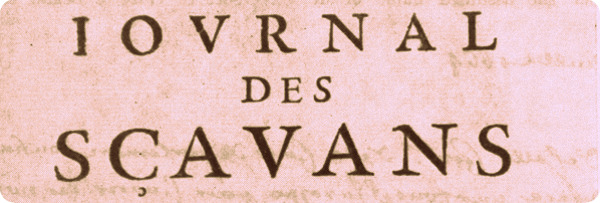Jean-Denis de Sallo, Paris and Amsterdam, 1665 (Gallica)
Lister noted that he had read the first 27 letters of the Journal des Sçavans: ‘13 de Hedoville et les 14 de l’anné suivante’. In other words, he read thirteen letters by le Sieur de Hedouville (pseudonym for the editor of the journal) and 14 letters from the 1666 edition published the following year. Le Journal des Sçavans was the earliest academic journal published in Europe, debuting a few months before the Philosophical Transactions of the Royal Society.
It was begun by Jean-Denis de Sallo (1626-1669) under the pseudonym, le Sieur de Hedouville, and ran from its first number in 1665, January 5 to the thirteenth number in 1665, March 30, when it was suppressed by the establishment. It resumed publication on 1666, January 4 under the editorship of le Sr. G. P. (that is, abbé Jean Galloys) for the years 1666-1674, then by abbée La Roque for 1674-1687, by Louis Cousin for 1687-1701, and a long sequence of other editors. 1
De Sallo stated that: ‘the design of this journal is to make known all that is new in the Republic of Letters’. As Mihnea Dobre indicated, de Sallo promised that he would:
keep the reader informed about new books published in Europe. This feature will not consist in lists of writings, but every report is expected to include a short description of the content of the book and its subject-area. Second, the journal aims to keep track of the deaths of famous people, which are expected of being announced together with a homage listing their most important books. Third, new observations, experiments, and discoveries will be mentioned:
We shall make known the experiments in Physics and Chemistry; which may serve to explain the effects of Nature, the new discoveries made in Arts & Sciences, such as the machines and the useful or curious inventions that can help Mathematics: observations of the Sky, of the Meteors, & what new things Anatomy may find in animals.
Fourth . . . the editor announces that the journal will take notice and will disseminate decisions made by the religious and secular courts, as well as censorship pronouncements. And finally, in the fifth place, a very general announcement: ‘there won’t be anything happening in Europe that is worth of the curiosity of the men of letters, which cannot be learned from this Journals. 2
As the Journal had such a general scholarly purpose, it is not entirely surprising that before the publication of the Philosophical Transactions, only four of the articles in the Journal were ‘scientific’. These articles concerned a comet, a ‘nouvelle fabrique’ from London, and another two articles about pendulums 3 The Royal Society, however, did borrow the first notice and review of Redi’s Observations of Vipers from the Journal des Sçavans in its February 1666 edition, a work that Lister had on his reading list.
- Scholarly Societies Project. ↩
- Mihnea Dobre, ‘Early Cartesianism and the Journal des Sçavans, 1665–1671′, Studium 4, 4 (2011). ↩
- Roger Philip McCutcheon, ‘The Journal des Sçavans and the Philosophical Transactions of the Royal Society’, Studies in Philology 21, 4 (October 1924), 626-628, on p. 626. ↩

